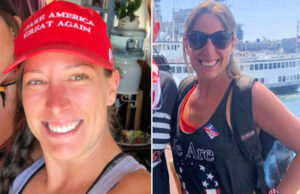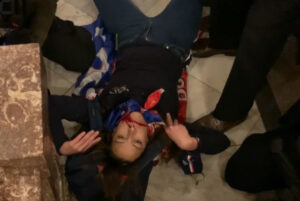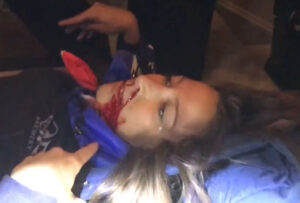(CONCLUSION of a 4 Part Report)
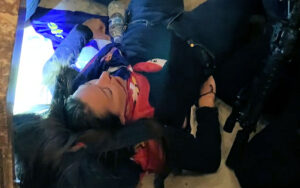
**WARNING** The screenshots at the end of this report of Ashli Babbitt after she was fatally shot are graphic. They are included because they visually convey the horror of a homicide for which there were zero repercussions.
“I tried to wait as long as I could. I hoped and prayed no one tried to enter through those doors. But their failure to comply required me to take the appropriate action to save the lives of members of Congress and myself and my fellow officers” — Lt. Michael Byrd speaking to NBC’s Lester Holt.
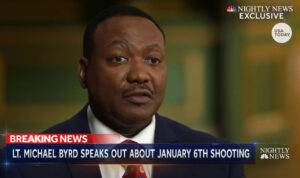
In the conclusion of this analysis (Part 4) we’ll examine in detail the last seconds of Ashli Babbitt’s life and how the Department of Justice’s investigation was predetermined from the start.
It would have been impossible to even consider allowing a Trump-supporting, Capitol trespassing, January 6th insurrectionist to become the sympathetic victim and a veteran African-American Capitol police officer to be tainted as the villain in this story.
The evidence strongly suggests that immediately after the homicide, a D.C. narrative quickly evolved that the shooter was the good guy and the deceased victim got what she deserved.
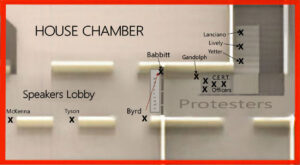 Inserted throughout the conclusion of this report are probing questions that should have been asked by either MPD or DOJ investigators. Here are some to Lt. Byrd and plainclothes officers McKenna and Tyson:
Inserted throughout the conclusion of this report are probing questions that should have been asked by either MPD or DOJ investigators. Here are some to Lt. Byrd and plainclothes officers McKenna and Tyson:
Q: Why did you take cover behind pillars in the Speakers Lobby after the House members had been evacuated?
Likely answer: Because we heard shots had been fired somewhere in the Capitol and thought this group of protesters might have firearms.
Q: Okay. But the attack on the eastern doorway’s windowpanes was taking place during the evacuation of House members out the western doorway as seen in videos. And since there is a clear line of sight between the eastern and western doorways, if any of the protesters had guns why didn’t they fire on the members when they had a clear shot?
Some might argue in Lt. Byrd’s defense that given his position in the Speakers Lobby, Byrd must have seen the three uniformed USCP officers on the other side of the doorway. Their armed presence is what prevented any armed protester from firing on House members due to the fear they would be shot in response. This is why he and the other plainclothes officers stayed hidden in the Lobby.
Of course, if Lt. Byrd, Sgt. McKenna and Officer Tyson had used this justification for taking cover, they would have been forced to admit they did indeed see the uniformed officers.
Again, Lt. Byrd to Lester Holt in his interview on NBC News: “Once we barricaded the doors, we were essentially trapped where we were. There was no way to retreat. No other way to get out.”
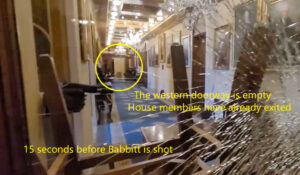
Not true. Photo #44 show they could have simply followed the House members down the stairway from the western lobby doors as shown in the screenshot.
Byrd added, “If they get through that door, they’re into the House Chamber and upon the members of Congress.”
Again, this contradicts what Officer Tyson said (“We got them out safely.” P.51) along with the video evidence. Lester Holt did not press him on any of these easily proven false allegations.
Q: Not one witness (police officer, civilian or protester) said they heard any warnings from any of you in the Speakers Lobby. And since you were all hidden behind pillars, no one even knew there were any officers in the lobby until your gun was seen less than 20 seconds before Babbitt was shot. Was just yelling, “stay back” sufficient for you before you shot? If not, what evidence did you see or hear that anyone actually heard you before you pulled the trigger?
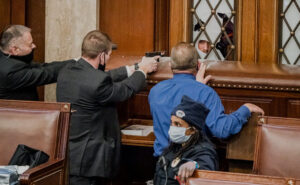
For Lt. Byrd and the other plainclothes officers in the Speakers Lobby, drawing their weapons and pointing them at the doorway was likely due to how other officers handled the situation when the members were still in the House Chamber as protesters pounded on the barricaded main entry doors.
Notice that in Photo #45 taken earlier, Capitol police officers had their guns drawn and pointed at the protesters as they faced them directly.
This was likely appropriate as members of Congress were still present. Lt. Byrd apparently took this same mind-set to the Speakers Lobby hallway. He drew his weapon and pointed it at the protesters on the other side of the barricade. But the two big differences were (1) he was hidden, not facing them directly and (2) there were no longer members of Congress to protect.
Q: If you had guns drawn and your sole purpose in doing so was to protect House members as they exited, why didn’t you stand behind the barricade and face the protesters directly like other Capitol officers did at the main door to the Chamber just minutes before?
Q: In other words, if you had adopted the same tactic as your fellow officers did in the Chamber (as seen in Photo #45), is it your belief that this woman would have still tried to climb through the open windowpane and ignored the gun she saw pointed directly at her?
What most likely occurred was Lt. Byrd, Sgt. McKenna and Officer Tyson were, as Sgt. McKenna testified, “scared shit” (P.44). They must have thought one of more of the protesters had firearms otherwise there would have been no reason to fear helmets and flagpoles when they were armed with Glocks. Or, McKenna and Tyson were simply following the lead of their lieutenant.
Until just a few seconds before Babbitt was shot, if any of these three officers had just stepped into the hallway with weapon drawn, it likely would have significantly changed circumstances leading up to the shooting. They would have been seen by protesters and police on the other side.
Clearly the doorway itself was a demarcation line. The behavior of police within literally 10 feet of the doorway on either side was astonishingly inconsistent even though there was a lieutenant on one side and a sergeant on the other. The sergeant was willing to step aside and give up the doorway to the protesters while the lieutenant was ready to use lethal force against any and all who breached it.
Sgt. Lively stated that he and his officers chose not to issue any verbal commands or physical force whatsoever to restrain the protesters as it might have been more inflammatory. He chose to give up the doorway to the most violent members of the mob even before the Containment Emergency Response Team (CERT) officers could replace them as guards. But he only abandoned the doorway when he saw the House members had safely exited and the tactical team was just a few feet away.
In other words when he stepped away from the doorway, Sgt. Lively deemed keeping protesters out of the Speakers Lobby then only for the protection of property, not people. His actions showed he didn’t consider denying the rioters entry into the lobby important enough to risk injury to himself or the officers he was responsible for.
It was an understandable but unfortunate decision.
Had he remained at the Lobby entrance for just a few seconds more until the tactical team arrived, it is likely seven heavily armed officers stationed in front of the doorway would have prevented further damage and assuredly denied entry. Ironically, this was exactly what Babbitt had been screaming for.
Yet on the other side of the doorway Lt. Byrd had clearly prepared himself in advance to use lethal force on whomever penetrated the doorway and entered the Lobby. Few places exist in the United States where one is executed just inches into an intrusion, especially when the outside guards cede the entrance by stepping aside.
DOJ INVESTIGATION AND CRIME SCENE PHOTOS
“I could not fully see her hands or what was in the backpack or what the intentions are,” Byrd said in the NBC News interview. “But they had shown violence leading up to that point.”
Byrd barely saw Babbitt’s backpack if at all. With his finger on the trigger Lt. Byrd was extending his weapon toward the opening considerably before she poked her head through that sidelight. His decision to shoot was premeditated at some point behind that pillar well before any backpack would have been visible to him.
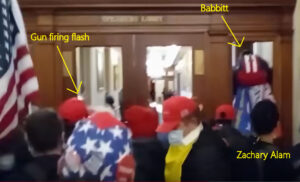
In fact, for the backpack to even be mentioned shows bias. Recall at the exact moment Babbitt was shot, her backpack barely crossed the threshold as seen in Photo #46.
Yet in his questioning (P.120), Officer Lanciano was pressed on the issue in order to support the overarching narrative (Babbitt was an insurrectionist trying to harm members of Congress):
MPD: Was there anything that she was wearing or carrying that gave you pause that she could be armed?
Lanciano: Uh, I believe that I saw a back pack on her.
Remember that Lanciano was not interviewed until February 4, 2021 which means the questioner had a month to thoroughly review the videos and autopsy report to well know that Babbitt was wearing a backpack.
MPD: Based on your experience as a police officer, what could be kept in a backpack?
Lanciano: (Correctly interpreting the question to imply that weapons could be hidden) Um, weapons, I mean, explosives, a whole number of things. (P.121)
Mostly though people keep things like what Babbitt actually had in her backpack, a black scarf, a gray beanie and a tan Eddie Bauer sweater. (P.246)
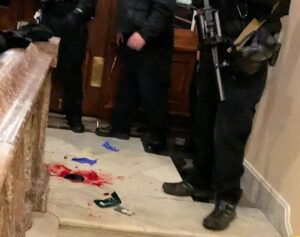
Though Capitol police cleared and took complete control of the crime scene, photos reveal it was significantly altered from inside the Speakers Lobby where protesters never entered.
Question for the Department of Justice investigators: Why was the crime scene altered and why was this not even mentioned in the final report?
After Babbitt was shot CERT Officer Brown actually climbed through one of the broken windows into the Speakers Lobby. (P.193) This is relevant based on the supposed “crime” scene photos below.
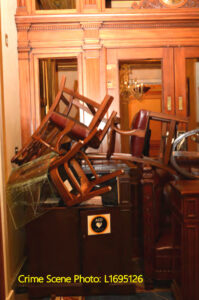
The very first thing one notices in these three “crime” scene photos is that the barricade has been altered. Chairs were clearly added after Babbitt was shot and after the CERT officer crawled through one of the open windows.
Notice the chairs are precariously perched on top of the shatterproof panes which were pushed through by Zachary Alam. There was no mention that the scene, which was immediately secured by police and protesters removed, was physically altered after the shooting. With the windowpanes out, the chairs could have easily been toppled had someone wanted to crawl through the windows so they added virtually no resistance or security.
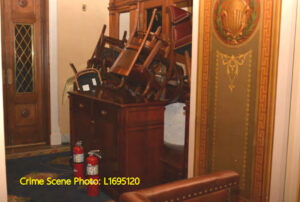
It seems the only possible reason would be show that visibility from the hallway into the outer vestibule area was so poor Lt. Byrd could not possibly see the USCP uniformed officers who were concealed by the barricade.

In his NBC News interview, Lt. Byrd said he couldn’t see that there were any officers on the other side of the doorway because of the furniture stacked on his side of the door. “It was impossible for me to see what was on the other side,” he said.
CONCLUSION
The Department of Justice’s Declination of Prosecution Memorandum stated:
“This declination is based on a review of law enforcement and civilian eyewitness accounts, physical evidence, recorded radio communications, cell phone footage, MPD reports, forensic reports, and the autopsy report for Ms. (Babbitt) McEntee. After a thorough review of the facts and circumstances in this case, there is insufficient evidence to prove beyond a reasonable doubt that Lieutenant Byrd violated Ms. (Babbitt) McEntee’s civil rights by willfully using more force than was reasonably necessary, or was not acting in self-defense or the defense of others.” (P.19)
By April 2021 the Department of Justice along with the Metropolitan Police Department of Washington, D.C. concluded what it called a thorough investigation. But it’s noteworthy that Sgt. Lively, Officers Yetter and Lanciano weren’t interviewed by the F.B.I. until early February, fully a month after the shooting. Officer Tyson, Sgt. McKenna and Lt. Byrd never faced one question from a federal investigator. They (Tyson and McKenna) were only questioned by the Metropolitan Police Department (of course, Lt. Byrd was never interviewed by law enforcement).
Referring to Lt. Byrd and Officer Tyson, the DOJ memorandum states, “While they were barricading the doors, a “mob of protestors” came to the doors…”
This is not true.
Before the first protester arrived, the doors had already been barricaded and three uniformed Capitol police officers were standing in front of them. How the DOJ could state this as fact is astonishing. It was easily verifiable.
Consider that this shooting was one of the highest profile homicides for many years in D.C. It should have been examined thoroughly. After all according to Politico the DOJ spent between $6 million and $26 million for a database of thousands of hours of video evidence from January 6th.
The Justice Department just took Byrd’s “statement” (debrief through his attorney) as fact without even superficially investigating its veracity.
TheAmericanCitizen.org first published Lt. Michael Byrd’s name as the shooter of Ashli Babbitt on July 14, 2021. Shortly thereafter, he became a highly protected man. On August 3, 2021 he was whisked outside the Washington beltway to Joint Base Andrews for nearly six months.
He and a pet stayed in the “Distinguished Visitor Suite” at the “Presidential Inn” that was paid for by the U.S. Capitol Police. According to Judicial Watch, this suite is normally reserved for military officials with the rank of Brigadier General or higher.
The declination memorandum also said that a “high level of intent” could not be established if the officer acted out of “fear, mistake, panic, misperception, negligence, or even poor judgment.” Is “panic …or poor judgement” an excuse for using lethal force on an unarmed woman? Apparently it was. In Lt. Byrd’s case it wasn’t even worthy of a day off without pay.
We’re left with the DOJ’s decision that it had no prosecutor who could make the case that a police officer, who said he issued verbal warnings that no one heard, emerged from hidden position and shot and killed an unarmed woman eight feet away was not “reasonably necessary” and did not violated Ashli Babbitt’s civil rights.
Based on the information contained in this four-part series, our conclusion after having watched all available videos and read all FOIA attained DOJ reports, is the Department of Justice knew soon after Babbitt was shot that there was no way it was going to prosecute Lt. Michael Byrd.
Its “investigation,” then, was initiated with the goal of supporting that predetermined conclusion.
In doing so, it knew that just the death of Babbitt would be insufficient. To justify the shooting it had to make Babbitt out to be committed member of the violent, riotous insurrectionists who got what she deserved.
The DOJ declination memorandum concluded: “Because Ms. McEntee” (Babbitt) “was an active participant in a ‘mob’ that had just illegally entered the Capitol building, and then broke out the glass doors and removed barricades to forcefully gain entry into the Speaker’s Lobby, there is insufficient evidence to refute Lieutenant Byrd’s fear for his life or the life of others at the time he discharged his weapon.” (P.32)
Babbitt was never part of this mob of protesters. She arrived alone and attempted to warn the three uniformed officers stationed at the doorway that they would need more help as there was a large, belligerent group behind her.
So with zero knowledge if she was part of this group or opposed to its tactics and trying to escape from them, a 27-year Capitol police veteran shot and killed the only woman at the scene.
Lt. Byrd was ready to shoot before Babbitt’s head appeared as she was climbing through. It is quite possible that had Mr. Gandolph, dressed in plainclothes, found himself alone, fearful of the protesters and tried to get away from them through the windowpane’s opening, Byrd may have shot him as well. After all, he was technically in with the mob. Guilt, and in this case, execution by association.
* * *
“An officer may use deadly force only when the officer reasonably believes that action is in the defense of human life, including the officer’s own life, or in the defense of any person in immediate danger of serious physical injury.” — The Capitol Police’s Office of Professional Responsibility.
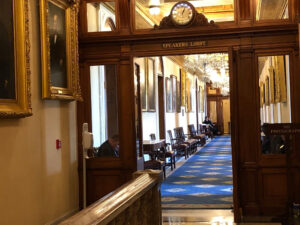
Two years later, the doorway has long been restored. Babbitt’s spilled blood is an increasingly distant memory for those who walk through the area. And after spending some time on administrative leave and in “protective” custody in his luxury suite at Joint Base Andrews, Lt. Michael Byrd is back in his original capacity in the House Chamber.
Lt. Byrd’s attorney, Mark Schamel, a well-known, high-priced defense attorney in D.C. said, “There’s no way to look at the evidence and think he’s anything but a hero.” (P.328) He added Byrd showed “tremendous restraint in firing just one shot.”
Lt. Byrd said in his interview with NBC News, “I believe I showed the utmost courage on January 6… I owned up to it. I was penalized for it. I moved on.”
Ashli Babbitt did not. She was shot at approximately 2:46PM on the afternoon of January 6, 2021. She was pronounced dead by a physician at the MedStar unit less than a half hour later.
